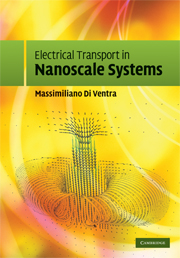Book contents
- Frontmatter
- Contents
- Preface
- 1 A primer on electron transport
- 2 Drude model, Kubo formalism and Boltzmann equation
- 3 Landauer approach
- 4 Non-equilibrium Green's function formalism
- 5 Noise
- 6 Electron-ion interaction
- 7 The micro-canonical picture of transport
- 8 Hydrodynamics of the electron liquid
- Appendices
- References
- Index
1 - A primer on electron transport
Published online by Cambridge University Press: 06 July 2010
- Frontmatter
- Contents
- Preface
- 1 A primer on electron transport
- 2 Drude model, Kubo formalism and Boltzmann equation
- 3 Landauer approach
- 4 Non-equilibrium Green's function formalism
- 5 Noise
- 6 Electron-ion interaction
- 7 The micro-canonical picture of transport
- 8 Hydrodynamics of the electron liquid
- Appendices
- References
- Index
Summary
Nanoscale systems
Let us briefly discuss the systems I will consider in this book, those of nanoscale dimensions (1 nm = 10–9 m). The phenomena and theoretical approaches I will present are particularly relevant for these structures rather than those with much larger dimensions.
So, what is a nanoscale system? The simplest – and most natural – answer is that it is a structure with at least one dimension at the nanoscale, meaning that such dimension is anywhere in between a few tens of nanometers and the size of an atom (Di Ventra et al., 2004a). One can then define structures with larger – but still not yet macroscopic – dimensions as mesoscopic. This separation of scales is arguably fuzzy. Mesoscopic structures share some of the transport properties of nanostructures; the theoretical description of both classes of systems is often similar; and in certain literature no distinction between them is indeed made.
Is there then, in the context of electrical conduction, another key quantity that characterizes nanoscale systems? As I will emphasize several times in this book, this key quantity is the current density – current per unit area – they can carry. This can be extremely large.
As an example, consider a wire made using a mechanically controllable break junction (Muller et al., 1992), a junction that is created by mechanically breaking a metal wire. Such a structure – a type of metallic quantum point contact – may result in a single atom in between two large chunks of the same material (see schematic in Fig. 1.1).
- Type
- Chapter
- Information
- Electrical Transport in Nanoscale Systems , pp. 1 - 38Publisher: Cambridge University PressPrint publication year: 2008
- 1
- Cited by



